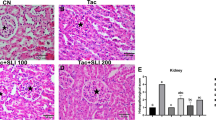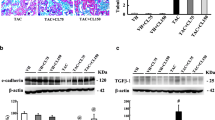Abstract
Tacrolimus (TAC), a calcineurin inhibitor (CNI), is clinically used as an immunosuppressive agent in the transplant recipient; however, the use of TAC is greatly limited by its nephrotoxicity and hepatotoxicity. Mycophenolate mofetil (MMF), an inhibitor of the purine synthesis, has been used in combination with many immunosuppressive drugs such as TAC. The association TAC/MMF was used in organ transplantation to increase the efficiency and reduce acute rejection rates, but the effects of MMF on TAC-induced kidney and liver injuries are still not well investigated. The aims of this study are to explore whether MMF co-administration with TAC has a renoprotective and hepatoprotective effect against TAC-induced renal and hepatic injuries and to check the implication of oxidative stress in the MMF’s possible protective effect. Our results showed that MMF (at 50 mg kg−1 body weight (b.w.)) restored creatinine, in addition to increased AST and ALT levels by TAC (at 60 mg kg−1 b.w.). Furthermore, MMF decreased DNA damage induced by TAC in the kidney and liver of rats as assessed by comet assay. This renoprotective and hepatoprotective effect of MMF was associated with an antioxidant effect. In fact, MMF co-treatment with TAC decreased oxidative damage induced by TAC. It reduced malondialdehyde (MDA) and protein carbonyl (PC) levels as well as catalase and superoxide dismutase (SOD) activities. We conclude that the co-administration MMF with TAC protect liver and kidney against TAC toxicity via an antioxidant process.





Similar content being viewed by others
References
Al-Harbi NO, Imam F, Al-Harbi MM, Iqbal M, Nadeem A, Al-Shahrah OA, Korashy HM, Al-Hosaini KA, Ahmed M, Bahashwar S (2014) Treatment with aliskiren ameliorates tacrolimus-induced nephrotoxicity in rats. J Renin Angiotensin Aldosterone Syst
Al-Harbi NO, Imam F, Al-Harbi MM, Iqbal M, Nadeem A, Sayed-Ahmed MM, Alabidy AD, Almukhallafi AF (2014) Olmesartan attenuates tacrolimus-induced biochemical and ultrastructural changes in rat kidney tissue. Biomed Res Int 2014:607246
Allison AC, Eugui EM (2000) Mycophenolate mofetil and its mechanisms of action. Immunopharmacology 47:85–118
Amin A, Hamza AA (2005) Oxidative stress mediates drug-induced hepatotoxicity in rats: a possible role of DNA fragmentation. Toxicology 208:367–375
Aust SD (1989) Metal ions, oxygen radicals and tissue damage. Bibl Nutr Dieta 43:266–277
Beckebaum S, Cicinnati VR, Klein CG, Brokalaki E, Yu Z, Malago M, Frilling A, Gerken G, Broelsch CE (2004) Impact of combined mycophenolate mofetil and low-dose calcineurin inhibitor therapy on renal function, cardiovascular risk factors, and graft function in liver transplant patients: preliminary results of an open prospective study. Transplant Proc 36:2671–2674
Beyer WE, Fridovich I (1987) Assaying for superoxide dismutase activity: some large consequences of minor changes in conditions. Anal Biochem 161:559–566
Bradford MM (1976) A rapid and sensitive method for the quantification of microgram quantities of protein utilizing the principle of protein-dye binding. Anal Biochem 72:248–254
Christians U, Kruse C, Kownatzki R, Schiebel HM, Schwinzer R, Sattler M, Schottmann R, Linck A, Almeida VM, Braun F (1991) Measurement of FK 506 by HPLC and isolation and characterization of its metabolites. Transplant Proc 23:940–941
Clairbone A (1985) Catalase activity. Handbook of methods for oxygen radical research. CRC, Boca Raton, pp 283–284
Collins AR, Dusinska M, Gedik CM, Stetina R (1996) Oxidative damage to DNA: do we have a reliable biomarker? Environ Health Perspect 104:465–469
Creput C, Blandin F, Deroure B, Roche B, Saliba F, Charpentier B, Samuel D, Durrbach A (2007) Long-term effects of calcineurin inhibitor conversion to mycophenolate mofetil on renal function after liver transplantation. Liver Transpl 13:1004
Dalal P, Shah G, Chhabra D, Gallon L (2010) Role of tacrolimus combination therapy with mycophenolate mofetil in the prevention of organ rejection in kidney transplant patients. Int J Nephrol Renov Dis 3:107–115
Engl T, Makarevi TJ, Relja B, Natsheh I, Müller I, Jonas D, Beecken WD, Blaheta RA (2005) Mycophenolate mofetil modulates adhesion receptors of the beta1 integrin family on tumor cells: impact on tumor recurrence and malignancy. BMC Cancer 5:4
Ferjani H, Achour A, Bacha H, Abid S (2015) Tacrolimus and mycophenolate mofetil associations: induction of oxidative stress or antioxidant effect? Hum Exp Toxicol
Fernandes MB, Caldas HC, Toloni LD, Baptista MA, Fernandes IM, Abbud-Filho M (2014) Supplementation with omega-3 polyunsaturated fatty acids and experimental tacrolimus-induced nephrotoxicity. Exp Clin Transplant 12:522–527
Fréguin-Bouilland C, Godin M, Bellien J, Richard V, Remy-Jouet I, Dautreaux B, Henry JP, Compagnon P, Thuillez C, Plissonnier D, Joannidès R (2011) Protective effect of mycophenolate mofetil on endothelial function in an aortic allograft model. Transplantion 91:35–41
Ganschow R, Albani J, Grabhorn E, Richter A, Burdelski M (2006) Tacrolimus-induced cholestatic syndrome following pediatric liver transplantation and steroid-resistant graft rejection. Pediatr Transplant 10:220
Gonzalez-Molina M, Ruiz-Esteban P, Burgos D, Rodriguez MA, Cabello M, Gutierrez E, Hernandez D (2012) Mycophenolate mofetil and tacrolimus reduce mortality after deceased donor kidney transplantation. Transplant Proc 44:2577–2578
Hortelano S, Castilla M, Torres AM, Tejedor A, Boscá L (2000) Potentiation by nitric oxide of cyclosporin A and FK506-induced apoptosis in renal proximal tubule cells. J Am Soc Nephrol 11:2315–2323
Hubner GI, Eismann R, Sziegoleit W (1999) Drug interaction between mycophenolate mofetil and tacrolimus detectable within therapeutic mycophenolic acid monitoring in renal transplant patients. Ther Drug Monit 21:536–539
Ibrahim MA, Ashour OM, Ibrahim YF, El-Bitar HI, Gomaa W, Abdel-Rahim SR (2009) Angiotensin-converting enzyme inhibition and angiotensin AT1-receptor antagonism equally improve doxorubicin-induced cardiotoxicity and nephrotoxicity. Pharmacol Res 60:373–381
Iwasaki K, Shiraga T, Matsuda H, Nagase K, Tokuma Y, Hata T, Fujii Y, Sakuma S, Fujitsu T, Fujikawa A (1995) Further metabolism of FK506 (tacrolimus). identification and biological activities of the metabolites oxidized at multiple sites of FK506. Drug Metab Dispos 23:28–34
Iwasaki K, Shiraga T, Nagase K, Tozuka Z, Noda K, Sakuma S, Fujitsu T, Shimatani K, Sato A, Fujioka M (1993) Isolation, identification, and biological activities of oxidative metabolites of FK506, a potent immunosuppressive macrolide lactone. Drug Metab Dispos 21:971–977
Johnson LB, Kuo PC, Dafoe DC, Drachenberg CB, Schweitzer EJ, Alfrey EJ, Ridge LA, Salvatierra P, Papadimitriou JC, Mergner WJ, Bartlett ST (1996) The use of bilateral adult renal allografts—a method to optimize function from donor kidneys with suboptimal nephron mass. Transplantation 61:1261–1263
Karabulut AB, Ara C (2009) Melatonin ameliorates tacrolimus (FK-506)’s induced immunosuppressive effect in rat liver. Transplant Proc 41(5):1875–1877
Khanna AK, Pieper GM (2007) NADPH oxidase subunits (NOX-1, p22phox, Rac-1) and tacrolimus-induced nephrotoxicity in a rat renal transplant model. Nephrol Dial Transplant 22:376–385
Klawitter J, Klawitter J, Schmitz V, Shokati T, Epshtein E, Thurman JM, Christians U (2014) Mycophenolate mofetil enhances the negative effects of sirolimus and tacrolimus on rat kidney cell metabolism. PLoS One 9:e86202
Ko MS, Choi YH, Jung SH, Lee JS, Kim HS, Lee CH, Kim SG (2015) Tacrolimus therapy causes hepatotoxicity in patients with a history of liver disease. Int J Clin Pharmacol Ther 53:363–371
Kino T, Goto T (1993) Discovery of FK-506 and update. Ann N Y Acad Sci 685:13–21
Mercier Y, Gatellier P, Renerre M (2004) Lipid and protein oxidation in vitro, and antioxidant potential in meat from Charolais cows finished on pasture or mixed diet. Meat Sci 66:467–473
Meier-Kriesche HU, Li S, Gruessner RW, Fung JJ, Bustami RT, Barr ML, Leichtman AB (2006) Immunosuppression: evolution in practice and trends, 1994–2004. Am J Transplant 6:1111–1131
Mesar I, Kes P, Hudolin T, Basic-Jukic N (2013) Rescue therapy with sirolimus in a renal transplant recipient with tacrolimus-induced hepatotoxicity. Ren Fail 35:1434–1435
Nieto E, Escudero E, Navarro E, Yanez-Mo M, Martin A, Perez de Lema G, Sanchez-Madrid F, Mampaso F (2002) Effects of mycophenolate mofetil in mercury-induced autoimmune nephritis. J Am Soc Nephrol 13:937–945
Ojo AO, Held PJ, Port FK, Wolfe RA, Leichtman AB, Young EW, Arndorfer J, Christensen L, Merion RM (2003) Chronic renal failure after transplantation of a nonrenal organ. N Engl J Med 349:931–940
Oto T, Okazaki M, Takata K, Egi M, Yamane M, Toyooka S, Sano Y, Snell GI, Goto K, Miyoshi S (2010) Calcineurin inhibitor-related cholestasis complicating lung transplantation. Ann Thorac Surg 89:1664
Picada JN, Flores DG, Zettler CG, Marroni NP, Roesler R, Henriques JA (2003) DNA damage in brain cells of mice treated with an oxidized form of apomorphine. Mol Brain Res 114:80–85
Randhawa MA (2009) Calculation of LD50 values from the method of Miller and Tainter, 1944. J Ayub Med Coll Abbottabad J21(3):184–185
Saad SY, Arafah MM, Najjar TA (2007) Effects of mycophenolate mofetil on cisplatin-induced renal dysfunction in rats. Cancer Chemother Pharmacol 59:455–460
Sacher VY, Bejarano PA, Pham SM (2012) Tacrolimus induced hepatotoxicity in a patient with bilateral lung transplant. Transpl Int 25:e111–e112
Singh NP, McCoy MT, Tice RR, Schneider EL (1988) A simple technique for quantitation of low levels of DNA damage in individual cells. Exp Cell Res 175:184–191
Starzl TE, Todo S, Fung J, Demetris AJ, Venkataramanan R, Jain A (1989) FK 506 for human liver kidney and pancreas transplantation. Lancet 2:1000–1004
Stillman IE, Andoh TF, Burdmann EA, Bennett WM, Rosen S (1995) FK506 nephrotoxicity: morphologic and physiologic characterization of a rat model. Lab Investig 73:794–803
Tada H, Nakashima A, Awaya A, Fujisaki A, Inoue K, Kawamura K, Itoh K, Masuda H, Suzuki T (2002) Effects of thymic hormone on reactive oxygen species-scavengers and renal function in tacrolimus-induced nephrotoxicity. Life Sci 70:1213–1223
Taniai N, Akimaru K, Ishikawa Y, Kanada T, Kakinuma D, Mizuguchi Y, Mamada Y, Yoshida H, Tajiri T (2008) Hepatotoxicity caused by both tacrolimus and cyclosporine after living donor liver transplantation. J Nippon Med Sch 75:187–191
Thomson AW, Bonham CA, Zeevi (1995) Mode of action of tacrolimus (FK506): molecular and cellular mechanisms. Ther Drug Monit 17:584–591
Tice RR, Agurell E, Anderson D, Burlinson B, Hartmann A, Kobayashi H, Miyamae Y, Rojas E, Ryu JC, Sasaki YF (2000) The single cell gel/comet assay: guidelines for in vitro and in vivo genetic toxicology testing. Environ Mol Mutagen 35:206–221
Tuñón MJ, Sánchez-Campos S, Gutiérrez B, Culebras JM, González-Gallego J (2003) Effects of FK506 and rapamycin on generation of reactive oxygen species, nitric oxide production and nuclear factor kappa B activation in rat hepatocytes. Biochem Pharmacol 66(3):439–445
Vincenti F, Laskow DA, Neylan JF, Mendez R, Matas AJ (1996) One-year follow-up of an open-label trial of FK506 for primary kidney transplantation. Transplantation 61:1576–1581
Wenceslau CF, McCarthy CG, Szasz T, Spitler K, Goulopoulou S, Webb RC, Working Group on DAMPs in Cardiovascular Disease (2014) Mitochondrial damage-associated molecular patterns and vascular function. Eur Heart J 35:1172–1177
Yadav DK, Gera DN, Gumber MR, Kute VB, Patel MP, Vanikar AV, Trivedi HL (2013) Tacrolimus-induced severe cholestasis complicating renal transplantation. Ren Fail 35:735–737
Zucker K, Rosen A, Tsaroucha A, de Faria L, Roth D, Ciancio G, Esquenazi V, Burke G, Tzakis A, Miller J (1997) Unexpected augmentation of mycophenolic acid pharmacokinetics in renal transplant patients receiving tacrolimus and mycophenolate mofetil in combination therapy, and analogous in vitro findings. Transplant Immunol 5:225–232
Zucker K, Tsaroucha A, Olson L, Esquenazi V, Tzakis A, Miller J (1999) Evidence that tacrolimus augments the bioavailability of mycophenolate mofetil through the inhibition of mycophenolic acid glucuronidation. Ther Drug Monit 21:35–43
Acknowledgments
This research was supported by the “Ministère Tunisien de l’enseignement Supérieur, de la Recherche Scientifique et des Technologies de l’Information et de la Communication” through the “Laboratoire de Recherche sur les Substances Biologiquement Compatibles” (LRSBC).
Author information
Authors and Affiliations
Corresponding author
Ethics declarations
Conflict of interest
The authors declare that they have no competing interests.
Rights and permissions
About this article
Cite this article
Ferjani, H., El Arem, A., Bouraoui, A. et al. Protective effect of mycophenolate mofetil against nephrotoxicity and hepatotoxicity induced by tacrolimus in Wistar rats. J Physiol Biochem 72, 133–144 (2016). https://doi.org/10.1007/s13105-015-0451-7
Received:
Accepted:
Published:
Issue Date:
DOI: https://doi.org/10.1007/s13105-015-0451-7




